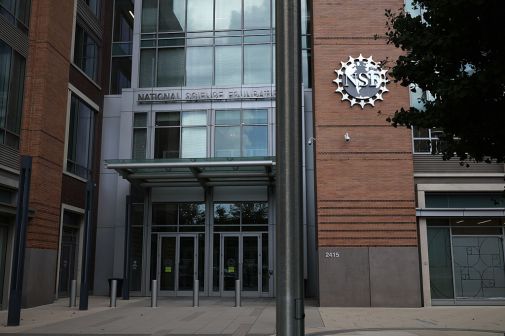An AI weather lab lost NSF funding. Its leadership says that could hurt the talent pipeline

An AI research institute funded by the National Science Foundation under the first Trump administration didn’t receive a renewal for five more years of federal support, a move that researchers told FedScoop deals a blow to its work as well as the talent pipeline.
The institute, known as AI2ES, is led by the University of Oklahoma and is focused primarily on researching the use of AI in applications for weather, climate and coastal oceanography. But when it came up for renewal earlier this year, Amy McGovern, the director and principal investigator for the institute, said it did not receive another round of support from the science agency.
That decision “destroys AI2ES,” McGovern said. Large-scale grants such as the NSF funding — which was roughly $20 million over five years — result in synergy across institutions that isn’t achievable with smaller awards to one or two researchers, she explained.
“We had seven universities involved, and people working together that wouldn’t normally work together producing amazing new results, and that’s going to stop,” McGovern said.
What’s more, the institute serves an important role as a training ground for undergraduate and graduate students, as well as post-doctoral researchers, who then take their skills into private industry. Without support for that training, the talent pipeline could suffer. “If we’re not doing it, who is doing it?” McGovern said.
Philippe E. Tissot, a co-principal investigator at AI2ES at Texas A&M University-Corpus Christi, similarly told FedScoop that the lack of funding feels like a missed opportunity for AI research.
“When you see the rest of the world, our competitors in other countries are not slowing down,” Tissot said. “We had this great program that was bringing in students from all around the nation to become AI experts, and it’s being cut quite a bit.”
AI2ES was initially announced as a recipient of one of the original National AI Research Institutes in 2020 along with six other awardees. That funding program is intended to fuel national research and development hubs for critical industry areas, as well as supporting spaces to train the future workforce. Over the years, the number of awardees has grown to 29 institutes, which are operated by multiple research institutions across the country, per the agency’s website.
It’s not exactly clear what NSF’s reasoning was not to renew, but a spokesperson told FedScoop in an email that the agency remains committed to advancing AI research through the institutes, which they called “a key part” of the Trump administration’s AI strategy and signaled that future awards may be possible.
“As several early Institutes reach the end of their planned award periods, NSF applauds the work of this pioneering cohort of AI Institutes. We are deeply grateful for the groundbreaking work of all AI Institutes and remain committed to building on their success to support the next generation of AI research and innovation. Additional award actions remain possible, subject to appropriations,” the spokesperson said in an emailed statement.
The institute currently has a year to finish its spending on the original grant in what’s termed a “no-cost extension,” McGovern said.
The funding decision comes as the Trump administration has appeared to show interest in the type of work the institute advanced, advocating for widespread use of AI — including its use in scientific research — and launching a public-private partnership to support increased AI education to build the workforce.
But at the same time, the second Trump administration has also scaled back NSF’s grants and prohibited funding to things that don’t align with the administration’s agenda, including research related diversity, equity and inclusion and environmental justice. The National Oceanic and Atmospheric Administration, similarly, has been the target of budget cuts proposed by the Trump administration, including a request to fully eliminate its office of Oceanic and Atmospheric Research.
The White House didn’t respond to a request for comment on its response to NSF’s decision.
Unique opportunity
At Texas A&M University-Corpus Christi alone, the NSF funding for AI2ES has supported a diverse group of roughly 50 graduate and undergraduate students that have given over 100 presentations as first-authors and won 14 awards, Tissot said. Ten of those students came from a community college, which was the result of direct recruitment efforts by the institute. Almost all of the students are American, he said.
“It’s a little disappointing because we’ve done so well, and I feel that we just need the students that we train,” Tissot said. “We need the young professionals that we train.”
For Texas A&M University-Corpus Christi, being a part of the institute has also been a unique opportunity.
Tissot said that Corpus Christi is what’s known as an “R2” institution, which is a research institution with a high volume of research activity but not quite as high as the top level of research institutions, known as “R1.” In the inaugural batch of AI Institutes, it was the only R2 organization to be named a co-lead, he said.
“Those kind of big research grants typically involve the bigger universities,” he said. But through its contributions, Tissot said the university has “shown clearly that we belong, and that was a great investment from our nation into this group of students.”
Impact on community
Alan Gerard, a retired meteorologist who had a roughly 35-year career at NOAA and its National Weather Service, told FedScoop that not having the pipeline from AI2ES is also a “serious concern for NOAA and the broader community.”
NSF-backed work is an important avenue for new scientists getting their experience and education, he said. “That’s not going to be there now.”
Gerard, who lives in Norman where the University of Oklahoma is located, was first to note that AI2ES had not been renewed in a post to his weather-focused blog. While at NOAA, he said there were even some discussions about how AI2ES could get involved with their testbed for hazardous weather.
“They were doing a lot of interdisciplinary work to ensure that AI guidance and AI-developed forecast products would be understood and trusted by forecasters and end users,” Gerard said.
But without them, it would be hard for NOAA to establish something similar to the institute on its own, and there may be an increased reliance on the private sector where a lot of AI meteorology is being done.
The use of AI in weather prediction has been a budding application of the technology for years and something that has bipartisan interest. Earlier this week at a Senate hearing on Trump’s AI Action Plan, Sen. Tammy Baldwin, D-Wis., asked Office of Science and Technology Policy Director Michael Kratsios how AI is being used in forecasting models and severe weather alerts, and how that could be expanded.
Kratsios partially deferred to NOAA but provided a brief statement of support for use of the technology in forecasting.
“The U.S., for many years, has been the proud home for some of the best weather forecasting in the world,” he said, “and I think AI will only be an accelerant and ensure that we can keep being as good as we are.”






